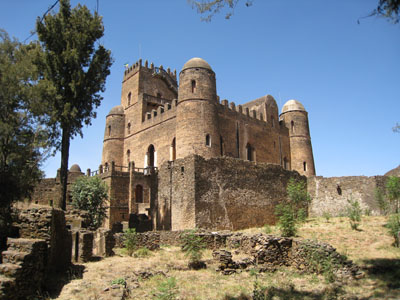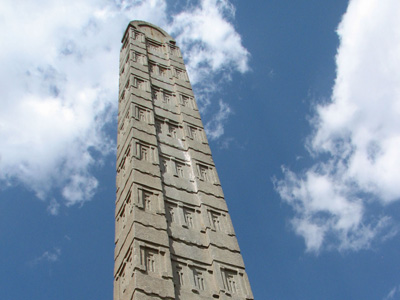Lalibela
The ancient Ethiopian empire in the north, came to an abrupt end, when a ferocious woman warrior named Queen Judith, led her tribes up from the Semien mountains and destroyed Axum, the capital.
After a power vacuum of nearly a century, the Zagwe dynasty came to power in the eleventh century. These dedicated Christian kings took it upon themselves to revive and restore the various churches destroyed by Judith.
There are no less than 1000 churches in the Lasta Region of Lalibela alone. Some are hidden in enormous caves, while eleven of these master craftsmanship are found in one locale, Lalibela, previously known as Roha.
These eleven churches are brilliant feats of engineering and architecture and are often referred to as the "Eighth wonder of the world".
The Lalibela churches are truly amazing because of two major features. The first one is the fact that these towering edifices were hewn out of the solid, red volcanic tuff on which they stand. In consequence, they seem to be of superhuman creation - in scale, in workmanship and in architectural concept.
The second amazing feature is the location where they are built. The destruction of the churches by Queen Judith may have warned the builders to hide these churches from future prying eyes and plundering hands of hostile interlopers.
Thus, when one approaches these churches from the road below, they remain little more than invisible against a horizon dominated by the 4,200-metre peak of Mount Abuna Yosef.
Even close-up, they seem wholly unremarkable, and it is this camouflaged, chameleon quality that may have kept them safe to this day.
'Lalibela churches, silence the most cynical pedants. Close examination is required to appreciate the full extent of the achievement because, like medieval mysteries, much effort has been made to cloak their nature.'
When an inquisitive mind compares the shabbiness of the present day lalibela town with the magnificence of the rock-hewn churches, one is forced to wonder why the extraordinary craftsmanship displayed in the building of the churches, did not 'rub off' even a little to the other local residences of the nobles.
Because of this, there are some that think that the builders of the rock churches actually lived somewhere else, but selected that spot because of its location.
The sheer magnificence of the craftsmanship make others wonder whether the art and the builders came from Egypt. This, at least can be refuted very easily because of two factors:
- There are no Egyptian buildings in Egypt that resemble the rock churches.
- The idea for the rock churches may have been taken from the various rock churches of Tigray built centuries ago. The fact that the water supply system is fashioned after the one at Debre-Damo Monastery, concludes that the origin of the art is Ethiopia, and the builders are Ethiopians.
With all said or some to be said regarding the Lalibela Churches, the fact that Lalibela is a secret marvel that was fashioned by a noble king, and maintains a special and lasting place in the life of the Ethiopian Christians, is clearly established.
Yemrehanna Kristos
The church of Yemrehanna Kristos, 'Christ Show Us the Way', is found north-east of Lalibela. This church was built by Yemrehanna Kristos, the predecessor of King Lalibela.
This remarkable church is a built up cave church in Axumite wood and stone construction, and has become famous for the decoration of its interior.
Neakuto Le’ab
King Nakuto Le’Abe, king Lalibela’s nephew and successor, abdicated his throne in 1270 AD and started living a hermit’s life in a cave, which has ever since become a monastery.
This cave church, 7 km from Lalibela, is a simple but attractive little church, built on the site of a much older shrine.
This monastery houses one of the most interesting collections of ancient crosses, illuminated manuscripts and other icons some of which are attributed to its founder Nakuto Le’Abe.
These pious four Zagwe kings ruled until the thirteenth century, when a famous priest, Tekla Haymanot, persuaded them to abdicate in favor of a descendant of the old Axumite Solomonic dynasty.
What motivated this persuasion is not clear. It may be the fact that the Zaqwe kings were more inclined to be hermits and monks rather than statesmen. As a result, a power vacuum may have been created that external aggressors may take advantage of, and their handling of the affairs of the state may have suffered. Whatever the reason is however, a single priest brought about the smooth transition from one dynasty to the other.
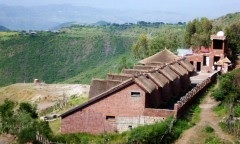 Maribela hotel is one of the best hotels in Lalibela. The hotel offers great view to the owe- inspiring Lalibela mountains. Rooms are spacious and well furnished. The tasteful interior decoration gives every guest the very best in Lalibela. Lovely flowers adorn the space in the private balcony. A cozy daybed is made available so you can enjoy the gorgeous views. The restaurant serves tasty Ethiopian and Continental dishes prepared by a team of culinary experts led by experienced chef.
Maribela hotel is one of the best hotels in Lalibela. The hotel offers great view to the owe- inspiring Lalibela mountains. Rooms are spacious and well furnished. The tasteful interior decoration gives every guest the very best in Lalibela. Lovely flowers adorn the space in the private balcony. A cozy daybed is made available so you can enjoy the gorgeous views. The restaurant serves tasty Ethiopian and Continental dishes prepared by a team of culinary experts led by experienced chef.
www.hotelmaribela.com.
 With striking architecture which uses the textures and colours of the famous Lalibela rock churches brilliantly reflected in its interior, the Mountain View Hotel is one of the new additions to the service industry in Lalibela. Perched at the edge of the Lasta Mountains, a short walk from the USESCO churches of Lalibela, it has amazing views from all of its 30 en-suite guestrooms. The restaurant offers international and Ethiopian cuisine and there is a large roof terrace, the perfect place to relax in the evening and enjoy the spectacular scenery.
With striking architecture which uses the textures and colours of the famous Lalibela rock churches brilliantly reflected in its interior, the Mountain View Hotel is one of the new additions to the service industry in Lalibela. Perched at the edge of the Lasta Mountains, a short walk from the USESCO churches of Lalibela, it has amazing views from all of its 30 en-suite guestrooms. The restaurant offers international and Ethiopian cuisine and there is a large roof terrace, the perfect place to relax in the evening and enjoy the spectacular scenery.
 Roha is a typical standard hotel, built and decorated to represent the historical, cultural and natural environment to Lalibela, home of the famous thirteen century rock- hewn churches that are designated as World Heritage by UNESCO. With its professional and experienced staff, Roha offers its guests comfortable rooms, the services of its bar and restaurant; and other vital services such as telephone, color TV with cable network, broadband internet connection.
Roha is a typical standard hotel, built and decorated to represent the historical, cultural and natural environment to Lalibela, home of the famous thirteen century rock- hewn churches that are designated as World Heritage by UNESCO. With its professional and experienced staff, Roha offers its guests comfortable rooms, the services of its bar and restaurant; and other vital services such as telephone, color TV with cable network, broadband internet connection.
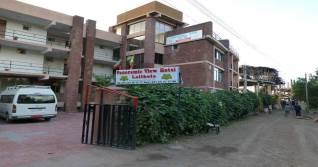 The Panoramic View Hotel has a total of 35 particularly designed rooms. Designed for convenience and featuring private balconies, all rooms have stunning views of the Ethiopian highlands. Traditional Ethiopian food as well as a variety of international dishes are available.
The Panoramic View Hotel has a total of 35 particularly designed rooms. Designed for convenience and featuring private balconies, all rooms have stunning views of the Ethiopian highlands. Traditional Ethiopian food as well as a variety of international dishes are available.
Web Site:- www.panoramicviewhotel.com
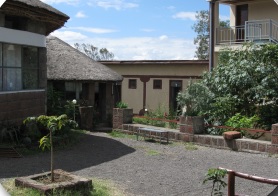 Jerusalem Hotel, formerly known as Jerusalem Guest House, is a friendly, family-run hotel, situated in the magnificent town of Lalibela. All our rooms are equipped with en suite, toilet and shower and water heater, and a private verandah. The front of the hotel looks on to the dramatic scenery of Asheton Mariam, while the verandas at the rear of the hotel provide stunning views of sunsets over the Simien Mountains. The restaurant and staff in this hotel is one of the best in Lalibela.
Jerusalem Hotel, formerly known as Jerusalem Guest House, is a friendly, family-run hotel, situated in the magnificent town of Lalibela. All our rooms are equipped with en suite, toilet and shower and water heater, and a private verandah. The front of the hotel looks on to the dramatic scenery of Asheton Mariam, while the verandas at the rear of the hotel provide stunning views of sunsets over the Simien Mountains. The restaurant and staff in this hotel is one of the best in Lalibela.
Web Site:- http://www.lalibelajerusalemhotel.com/
 Lalibela lodge has a total of 10 rooms that can be configured into any variety of twins, double and triple rooms. All rooms come with their own private balcony or veranda and are south facing to allow you to take full advantage of the magnificent mountain scenery. This hotel is one of the recommended hotels in Lalibela.
Lalibela lodge has a total of 10 rooms that can be configured into any variety of twins, double and triple rooms. All rooms come with their own private balcony or veranda and are south facing to allow you to take full advantage of the magnificent mountain scenery. This hotel is one of the recommended hotels in Lalibela.
Web site:- www.lalibelalodge.com





